Christian Krausch
ANGELO EVELYN, COMBINATIONS
“If by way of peculiar
similarities the strangest things
converge in a time and a place, then there originate
wond’rous units and fantastic combinations” (Novalis) |
What impact has the biography of an artist on
the outcome of his art? For anyone confronting the oeuvre of Angelo Evelyn,
it is indeed a question that can be seriously posed. As a central problem
of art criticism, it has always been answered in different ways depending
on the tastes of the viewer.
This is not simply because this native Canadian of Anglo-Italian
descent has been living for various periods of time in Canada, Germany,
France, Great Britain, Norway and the Netherlands. Telling us, occasionally,
the local origin of some of his works when we expect in fact only such
details as title, size, and technique used. It is not even because a conversation
with the artist, born in 1942, presupposes being at home in many languages.
If one decides to look for biographical influences in
Angelo Evelyn’s works, then this quest is justified in the form of stylistic
criticism. The biography (or thus, life??) plays a key role in the final
analysis in the content, the iconography and in the pure formal elementary
aspects and is clearly evident in his artistic interaction.
Since the beginnings of his artistic career in the late
70’s when he took up his studies at the art academy in Bremen in printmaking
and painting, Angelo Evelyn has never restricted himself to a single technique
nor an approach. On the contrary, his entire oeuvre resembles somewhat
a collage; stylistically and in terms of the material used, its mixed media
character is clearly apparent.
Paintings done in oil and acrylic, drawings in pencil,
ink and charcoal, the repeated use of stencils, the montage of his own
subjects or subjects from other sources: They all mark and characterize
his development just as much as his use of different printmaking techniques,
especially in the
framework of lithography. Similarly diverse is his choice
of subjects, occasionally single portraits, but also presentations of abstract
animal forms or their interpretation showing a close affinity to the natural
sciences. In 1998, the artist dedicated a number of graphic works to his
parents. They were done in mixed printmaking techniques on paper using
photographs as their point of departure.
About eight years earlier, during a lengthy stay in Norway,
originated various studies of the whale as subject. Due to an emotional,
introspective turn of the artist, this theme was later substituted by images
of worms and other terrestrial beasts.
At the beginning of his art education one discovers the
pig as subject. Incorporated into an expressive painting, there is evidence
of an affinity to the manner of Francis Bacon. In later works, however,
the silhouettes of (stencilled) camels and sheep point to the iconography
of pop art.
As themes in some lithographic prints from 2001 Evelyn
discovered the pictorial qualities of single quartz and calcite crystals
and their inherent regular (geometric) shapes and play with refracted light.
The only continuous and thus recognizable aesthetic characteristic
of Evelyn’s oeuvre is the coexistence of diverse spatial levels (in other
words, degrees of figuration and temporality in the same work of art).
Some examples such as “The Transformation of the 4 Elements”
(1982) and “ Animal Crackers or Dr. Livingstone I Presume” done in the
same year come alive through the layering of diverse themes (motives) and
narrations tied together with mixed media techniques incorporating painting,
drawing and lithographic printing.
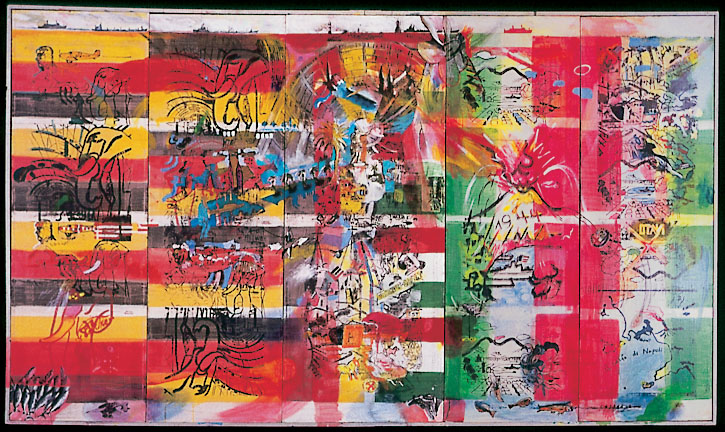
Transformation of the Four Elements
In a certain sense, Evelyn’s works appear as a representation
of complex connections and not as the depiction of single motifs or themes.
The starting point for this play with multiple layering
(or strata) is surely due to Evelyn’s pre-artistic education. Again and
again, texts on the artist note that he completed his studies in mathematics
and physics and worked in various technical fields before he turned to
art.
The fact that his oeuvre developed through a process of
adding idea to idea and layer onto layer was observed by other critics,
as well. Thus, his former teacher, Karl- Heinz Greune in Bremen, in 1983
recognized “the developmental thrusts that took the form of over-painting.”
It is an aspect that remains typical of Evelyn for a long time now. In
fact it follows that the hypothesis of a coloured gesture is immediately
replaced by the counter-hypothesis of a linear form or an assumed or incompletely
present figuration. Over and over again, there appear text fragments or
individual words on the surface of paintings, not so much as a description
or explanation but rather as independent iconographic elements.
The purpose for all the various assertions occurring in
a given picture is by no means to come to a final, clear and unequivocal
conclusion as to the ultimate meaning of such a work. Evelyn leaves that
trace of openness and sometimes enigma to his works which is a prerequisite
for a continuous confrontation with them.
However, in the final analysis it is obvious that hinting
at the formulas and structures of certain sciences perhaps omits a more
significant if not the most significant nucleus of Evelyn’s art. Despite
a tendency of reduction (and, in fact, simplification of the use of art
materials) that has become more and more visible over the years, and notwithstanding
an increasing concentration on one-dimensional offensive statements (or
strategies) that address the observer emotionally and or intellectually,
it is still the experience, emotion and awe of the artist confronted with
life and its testimonies which takes preference among all the possible
points of departure.
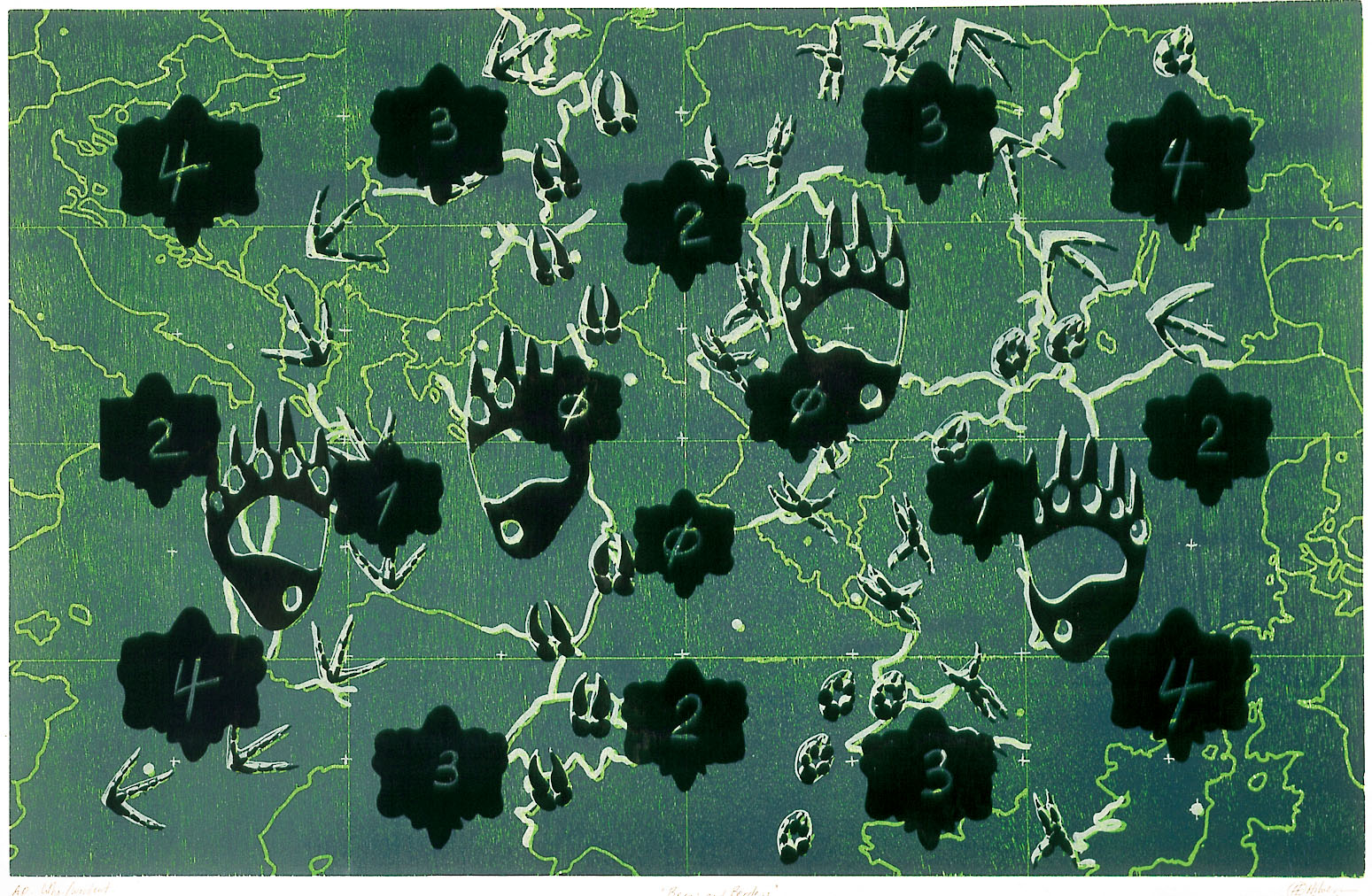
Bears
The series “Keys to Global Warming” from 1998 is for instance
based on images of weather maps taken from newspapers and combined with
the silhouette of a key. Similarly, the series “Bears, Bulbs, Brains, Backbones,
and Borders,” completed two years later and done on the basis of a re-worked
map of Europe dissected into 16 parts, clearly reflect Evelyn’s physics
and natural history background but also his expressive freedom as an artist.
The same is true of three woodcut and lithography prints, “The lungs of
the Earth I, II, III ,“ which owe their statement to the connecting of
chestnut leaves with a view of a lung as suggested from an X-ray image.
On closer scrutiny, the partly legible written text that has been integrated
into the works appears as a formula for photosynthesis. In this way, Evelyn
once again unites in his works factual objectivity and the fascination
with processes normally studied in the context of the natural science.
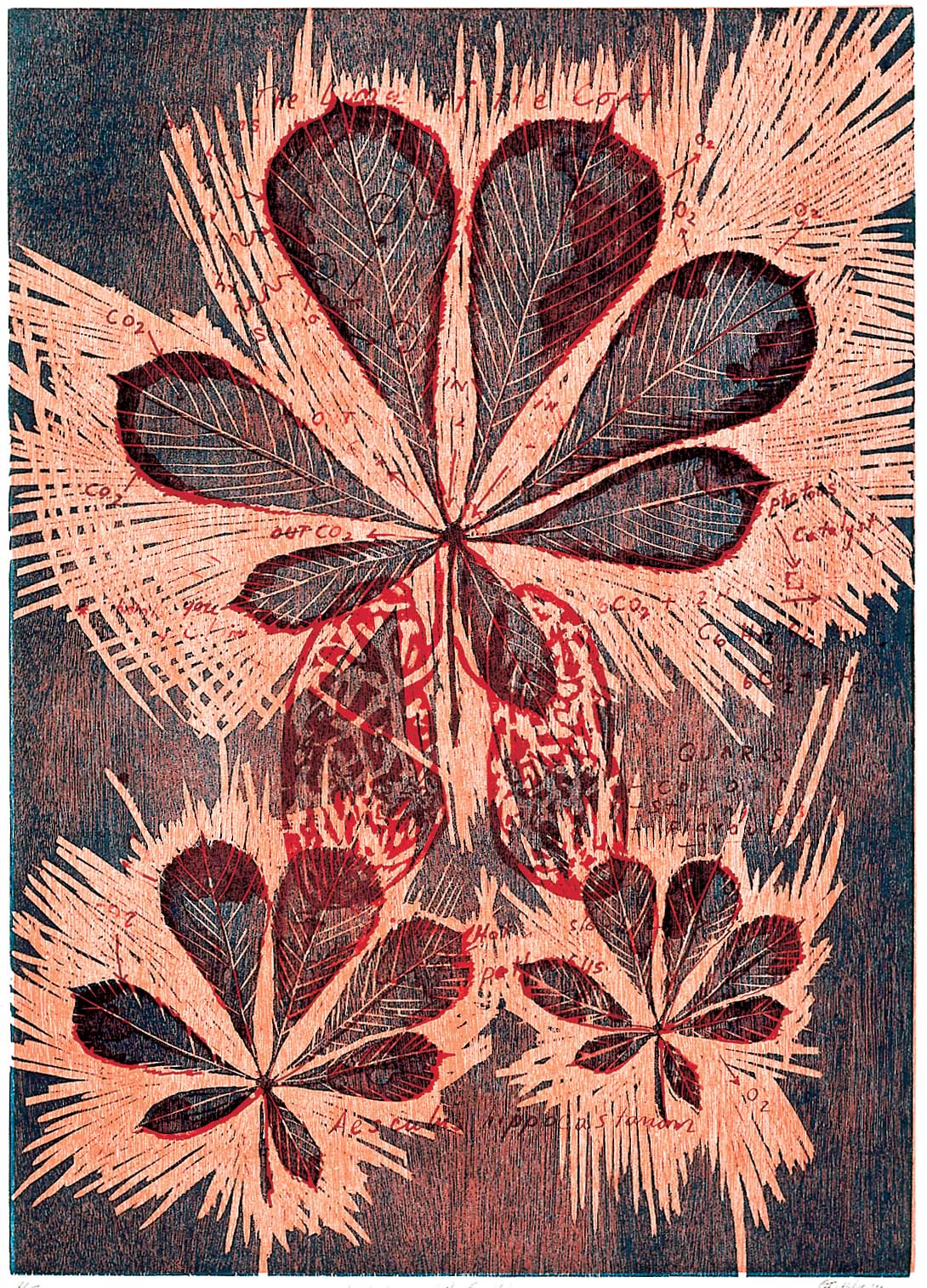
Lungs of the Earth III
A generous field for such an emotional confrontation is
also apparent in the landscape motifs which have been part of Evelyn’s
works over the years. Some early example of these can be found in such
major paintings already done in 1982 as “Kriegs Mythos” and “Zen
Taurus”,
tachist and expressive works imbued with landscape motives
by way of which Evelyn was beginning to consolidate his personal artistic
point of view.
The stylistic closeness to Francis Bacon and the thematic
research of the figure and space which were typical of him at the time
of his studies at the art school in Bremen in 1979 and 1980, have been
left behind now. Henceforth it is the landscape subject which in 1983 drew
attention by way of integrated postcard images as in “Dutch Tulip Landscape
or Alternative Energy” or in “Deja-Vue or Why Wait for Spring Do it Now.”
They also formed variations of fantasy-filled areas full of camels and
sheep as in “Desert Landscape” and “Umbrian landscape".
In 1985 Evelyn dedicated himself to the “Canadian Island,”
as a theme
which for biographical reasons, in varied form through
the years, remained important. Already in the same year the image appears
in copied and over-painted form four times in “All the four Seasons” or
in “Two Views of a Canadian Island”.
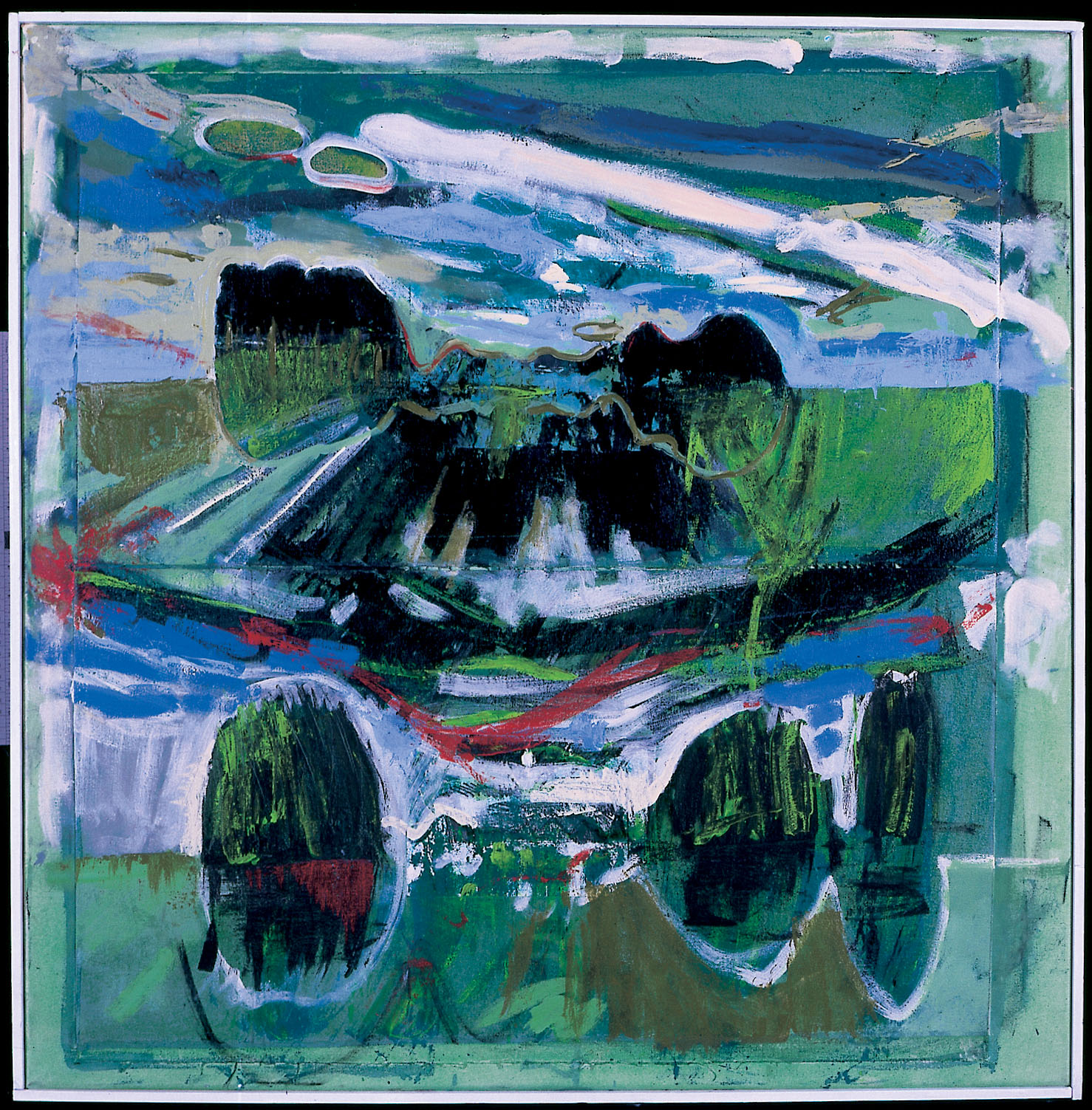
Two Views of A Canadian Island
Determined by his stay in Norway in 1988, Evelyn assessed
the depth of the “North-Sea Landscape” in a series of large-scale
works in which his perspective changes occasionally from the accustomed
horizontal to a birds–eye view. Mirror-like inversions of elements within
a work, as well as a calligraphic use of iconographic language underscore
the narrative qualities of these works. We encounter them again in 1997
in the lithography and woodcut, “A View from Lord Elgin’s Pathfinder”.
Once again, Evelyn changes his point of view and develops a fictitious
perspective of the Martian surface, which we perceive as a red landscape
with a large number of rocks strewn across it.
Seemingly like a kind of horizon, in front of which the
diverse themes of his works are enacted, the landscape - in the form of
a quotation or visual motif - forms the tie that holds together the iconographic
cosmos of Angelo Evelyn.
The recurrence of such landscape-like spatial formations
is, in terms of stylistic criticism, the connection between almost all
of his works. As if the artist was in this way integrating his ideas and
questions into a natural environment, in order to point to their general
validity and relevance. (We see that they relate in many ways to the present,
while being dominated by an awareness of personal responsibility; they
are in fact interpretable as social criticism.)
What does a traveller do when he arrives in a foreign
place? He perceives it in the first place as a geographical landscape.
William Turner demonstrated this masterfully. Only after some time has
relapsed, the theatre of nature is replaced by the complexity of the landscape
as an ambience of humans and animals.
The term “Kulturlandschaft” (cultural landscape)
takes on an entirely new dimension. Thus “landscape” does not merely mean
the horizontal glance on things from the outside. The works of Angelo Evelyn
are rather to be understood as reflections of his inner landscape, as mirrors
of a traveller whose “place of home appears in the plural” (Greune).
If one is to consider the consistency in Angelo
Evelyn’s artistic engagement one cannot help but to reflect on his printmaking.
Evelyn has learned graphic printmaking techniques, he has studied them.
He has become a master. Their skilled use in almost all phases of his oeuvre
determines the latter and applies its stamp to it (sic!). The quality of
his graphic work is considerable. They posses a high degree of autonomy
as is apparent in the case of the etching “The BM celebrates the Millennium”
(1997), as well as the lithography “Drie Madonnen” (2001). Angelo Evelyn’s
artistic prints are not only supports for the duplication of interesting
motifs, but serve at times in much larger compositions. Still, there is
sometimes a certain static quality apparent to them. Thus the prints from
the series “Calcite” from 2001, leave in their attractiveness an almost
monolithic impression on the viewer.
 The BM Celebrates the Millenium
The BM Celebrates the Millenium
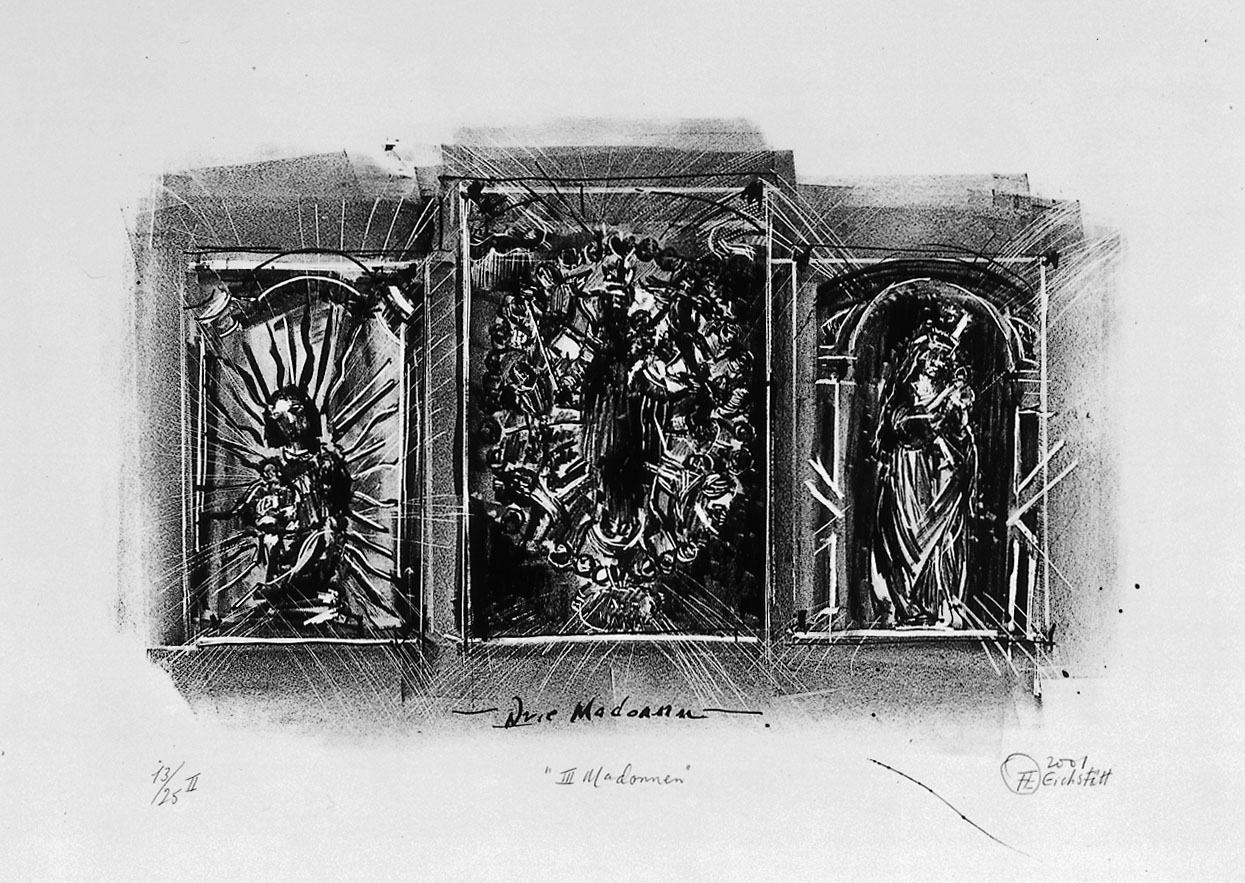
Drie Madonnen
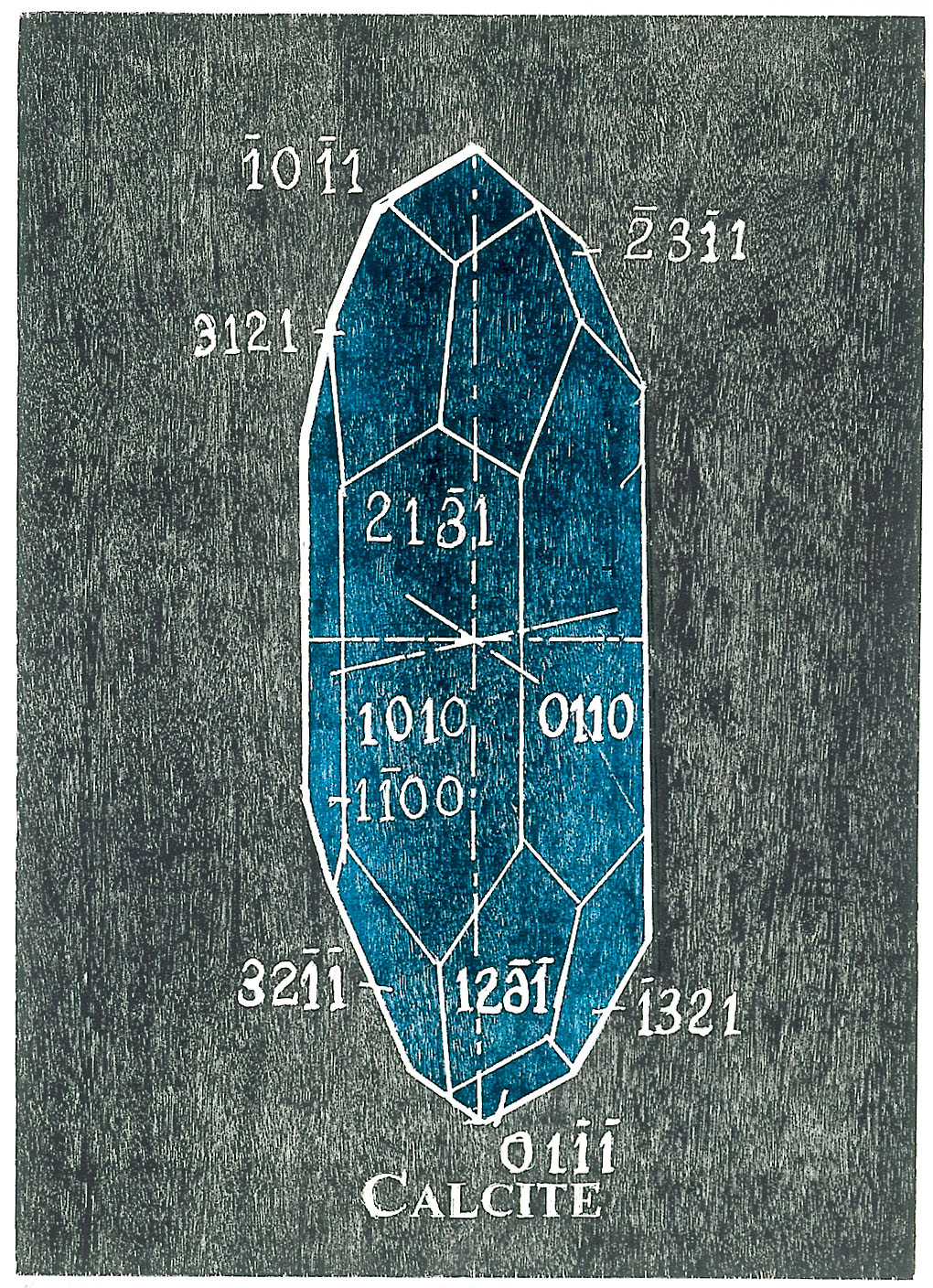
Calcite
In spite of this, the immediacy of the moment fails in
them which the paintings otherwise give rise to (as the presence or awareness
of a situation in the artist). The graphic media are first of all a means
of transition (and transmission) whose technical requirements often have
a constraining effect on the execution of a work.
As a consequence of this, in the last two or three years
there is a tendency which can be felt, of the artist moving away from printmaking
and turning back to painting and drawing. While withdrawing from what perhaps
is for him the most technological among the artistic possibilities in his
repertoire, Evelyn escapes the verdict of precision in favour of a more
spontaneous means of expression. The works regain a greater freedom and
ease.
The most recent landscapes, among them once more a return
to the sujet of Canadian islands, come across as more open, freer; they
incorporate larger spatial relationships, without the necessity for action
or figuration in the intermediate stage of their formulation.
Memories of Norwegian stave churches offered the
pretext, in 2002, for the painting “Norwegian Stave Church Landscape,”
a work which just as “Saltspring Island” shows obvious tendencies towards
abstraction.
Consistently, since 2002 have originated numerous works,
of which “A Question of Containment I” and “II” are examples which have
freed themselves nearly completely of figurative elements.
This form of abstraction is a result of Evelyn’s development
which has lead the artist from graphic works via painting to prints and
their combinations. We get the impression somehow that Angelo Evelyn is
now exploring painting with regard to its true possibilities, as printmaking
can no longer tell him anything new.
But, to come back to it, what is our conclusion
with regard to the influence of an artist’s biography on the outcome of
his art? In the case of Angelo Evelyn, the answer could be: If by ‘biography’
we mean not simply his social development and professional career but all
the places where he has lived, all the questions posed, the persons loved,
the landscapes seen and experienced, the answers obtained, the illnesses
overcome, and the works completed, then indeed the biography and the oeuvre
can be seen as mutually pervading each other in the form of a ‘set’ of
‘solutions on offer.’ As Angelo Evelyn proves, this ‘set’ is almost inexhaustible.
Translated by AW
© for the original German text (and translation rights) by Dr.
Christian Krausch, art historian, Moenchen-Gladbach
|